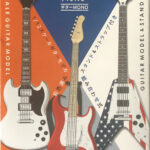Want to expand your guitar chord vocabulary quickly and effectively? Many aspiring guitarists feel overwhelmed by the sheer number of chords to learn. The secret is understanding chord shapes. Instead of memorizing hundreds of individual chords, you can learn a handful of fundamental shapes and apply them across the fretboard to unlock a vast range of chords.
This guide will introduce you to 10 essential Guitar Chord Shapes that are foundational for any guitarist. Mastering these shapes will dramatically accelerate your learning process and allow you to visualize chord progressions and changes with ease. Let’s dive in and explore these building blocks of guitar mastery.
Power Chords: The Rock Guitar Staple
Power chords are the bedrock of rock, punk, and metal music. Their simplicity and raw energy make them incredibly versatile and easy to learn. Consisting of only three notes – the root, fifth, and octave – power chords are neither major nor minor, giving them a powerful, ambiguous sound. The name of the power chord comes directly from its root note, the lowest note you play. For example, if you play a power chord shape starting on the 5th fret of the low E string, you’re playing an A5 power chord.
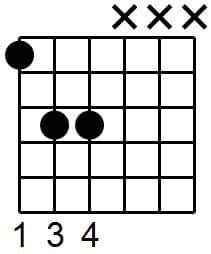 Power chord diagram for A5, rooted on the low E string
Power chord diagram for A5, rooted on the low E string
This versatile shape can also be moved and rooted on the A string for different power chords.
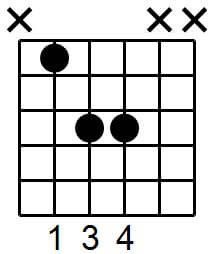 Power chord shape rooted on the A string (5th string)
Power chord shape rooted on the A string (5th string)
And even on the D string, expanding your power chord possibilities further up the neck.
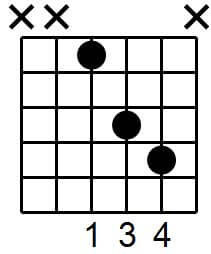 Power chord shape rooted on the D string (4th string)
Power chord shape rooted on the D string (4th string)
6-String Major Barre Chords: Unlock Full Barre Chord Voicing
Barre chords are notorious among beginner guitarists, often perceived as difficult to master. However, they are indispensable for playing a wide variety of songs and styles. A barre chord involves using your index finger to “barre” or press down multiple strings at once, effectively acting as a movable nut.
The 6-string major barre chord shape is derived from the open E major chord. If you play an open E major chord, notice how your index finger is free. By visualizing this shape and moving it up the neck, using your index finger to barre all six strings where the nut would be in the open E position, you create a movable major chord shape. The root of this chord is on the 6th string.
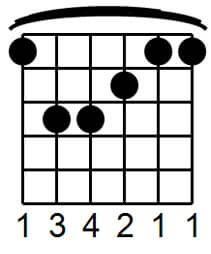 6-string major barre chord shape derived from E major
6-string major barre chord shape derived from E major
6-String Minor Barre Chords: The Minor Variation
Transforming a 6-string major barre chord into a minor barre chord is surprisingly simple. The key difference between major and minor chords lies in the third of the chord. In a 6-string major barre chord, the major third is played by your middle finger on the G string.
To convert it to a minor chord, you need to “flatten” this major third, lowering it by a half step (one fret). In this barre chord shape, the note you need to flatten is already being fretted by your index finger as part of the barre. Therefore, to create a 6-string minor barre chord, simply remove your middle finger from the G string. This shape closely resembles the open E minor chord shape.
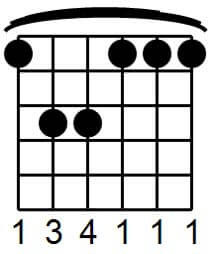 6-string minor barre chord shape resembling E minor
6-string minor barre chord shape resembling E minor
5-String Major Barre Chords: Rooted on the A String
Major barre chords aren’t limited to the 6th string root. They can also be rooted on the 5th string (A string), offering another set of movable major chord shapes. This 5-string major barre chord shape is based on the open A major chord shape. It can be a bit trickier to fret cleanly initially, so practice and finger strength are key. For helpful tips and shortcuts on mastering this shape, many online resources and video lessons are available.
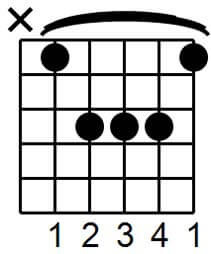 5-string major barre chord shape rooted on the A string
5-string major barre chord shape rooted on the A string
5-String Minor Barre Chords: A Minor Shape on the Barre
Just like the 6-string barre chords, you can easily convert a 5-string major barre chord into a minor chord. Again, the change involves flattening the major third. In the 5-string major barre chord shape, the major third is located on the B string. By adjusting your fretting hand to effectively remove or flatten this note in the chord shape, you create a 5-string minor barre chord. This resulting shape shares similarities with the open A minor chord.
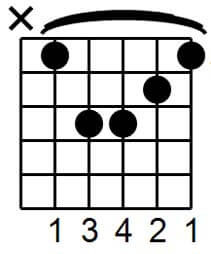 5-string minor barre chord shape similar to A minor
5-string minor barre chord shape similar to A minor
6-String Dominant 7th Chords: Adding Bluesy Flavor
Dominant 7th chords add a bluesy, jazzy, or funky dimension to your playing. They are often used in place of regular major chords to create more complex and interesting chord progressions. The 6-string dominant 7th chord shape is derived from the 6-string major barre chord shape. The modification is simple: remove your pinky finger from the high E string. This pinky finger was playing an octave of the root note, which can be omitted to introduce the b7th note, the defining characteristic of a dominant 7th chord.
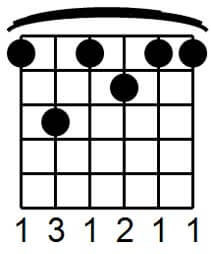 6-string dominant 7th chord shape, modified from major barre
6-string dominant 7th chord shape, modified from major barre
5-String Dominant 7th Chords: A String Rooted 7th
Similar to the 6-string version, the 5-string dominant 7th chord shape is derived from its major counterpart. Start with the 5-string major barre chord shape (rooted on the A string). The adjustment to create a dominant 7th involves lowering the note that creates the major third to a minor third (b7th in relation to the root of the 7th chord). In practice, this often means slightly adjusting your finger position within the barre chord shape, or removing a finger if that’s how you are fretting the major shape.
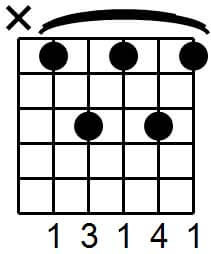 5-string dominant 7th chord shape, A string root
5-string dominant 7th chord shape, A string root
6-String Minor 7th Chords: Melancholy and Smooth
Minor 7th chords possess a melancholic yet sophisticated sound, frequently used in jazz, blues, and R&B. To create a 6-string minor 7th chord shape, start with the 6-string dominant 7th chord shape. Remember that dominant 7th chords contain a major third. To transform it into a minor 7th, you need to flatten that major third, making it a minor third. For the 6-string shape, this is achieved by removing the middle finger, which was fretting the major third on the G string in the dominant 7th shape.
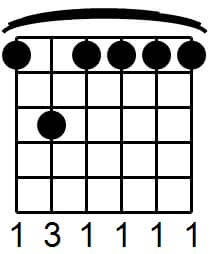 6-string minor 7th chord shape, derived from dominant 7th
6-string minor 7th chord shape, derived from dominant 7th
5-String Minor 7th Chords: A String Rooted Minor 7
The same principle of flattening the major third applies to create a 5-string minor 7th chord. Begin with the 5-string dominant 7th chord shape. By flattening the major third within this shape, you convert it into a 5-string minor 7th chord. This adjustment might involve removing a finger or slightly altering your finger placement within the barre shape depending on your fretting technique.
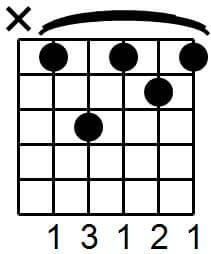 5-string minor 7th chord shape, A string root, minor variation
5-string minor 7th chord shape, A string root, minor variation
7#9 Chords (The Hendrix Chord): Funky Blues and Rock
The final essential chord shape is the 7#9 chord, famously known as the “Hendrix chord” due to its frequent use by Jimi Hendrix. This chord is a staple in funky blues and rock styles. While named a “7th” chord, it’s a unique variation. Rooted on the A string, it features the root, major third, and b7, but omits the 5th from the major scale that a full dominant 7th chord would have. The distinctive #9 note is played on the B string, giving it a characteristic dissonant and bluesy flavor. This chord is perfect for adding a funky edge to your rhythm playing.
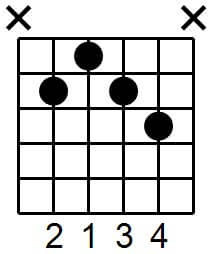 7#9 chord shape, also known as the Hendrix chord
7#9 chord shape, also known as the Hendrix chord
By learning these 10 fundamental guitar chord shapes, you’ve gained a powerful toolkit for playing a vast array of chords across the fretboard. Practice these shapes in different positions and experiment with incorporating them into your playing. You’ll be amazed at how quickly your chord vocabulary expands and your understanding of the guitar deepens!

